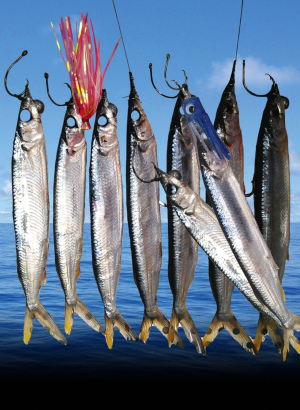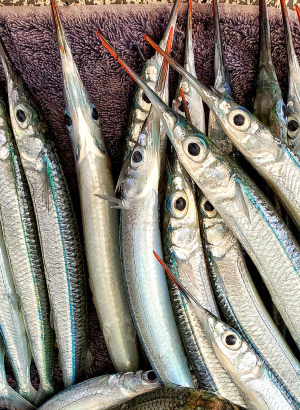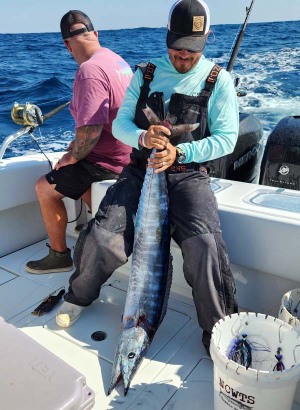The Ballyhoo fish, part of the halfbeak family, is a renowned predator in the Atlantic ecosystem. They are found in warm currents from New England to Brazil, providing sustenance to larger predators. Anglers find the Ballyhoo fish both formidable adversaries and prized quarry, with their agility and speed making them a prized quarry. In The Spread aims to educate and inspire curiosity about the Ballyhoo fish and its role in the aquatic ecosystem.
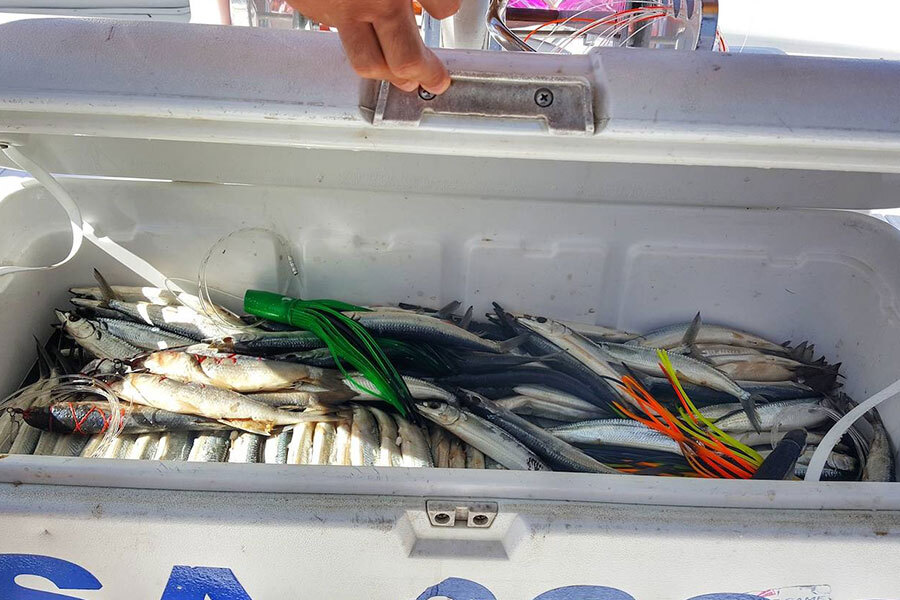
Ballyhoo Fish – Bait Rigging Insights
Guide to Ballyhoo Fish: Bait Rigging Techniques and Offshore Fishing Tips
In the vast and mysterious brine, a myriad of creatures dwell, each endowed with its own peculiarities, and each holding the key to the mastery of the watery realm. One such denizen of the deep, the Ballyhoo fish, with its elongated, slender body and uniquely protruding lower jaw, has captivated the hearts and minds of those who dare to tread upon the surface of Neptune's domain.
The Ballyhoo, or Hemiramphus brasiliensis, as it is known among the learned, belongs to the family of halfbeaks, a name derived from the striking appearance of their beaks, with the lower jaw extending far beyond the upper, tapering to a fine point. This piscine peculiarity, a marvel of nature's design, has evolved to serve these creatures well in their ceaseless quest for sustenance.
As they glide effortlessly through the azure waters, Ballyhoo fish are found in the warm currents of the Atlantic, spanning from the coast of New England to the sun-kissed shores of Brazil. They roam these vast expanses in great schools, their silvery bodies shimmering in the dappled light that filters through the briny deep.
In their role within the aquatic ecosystem, these denizens of the deep are a vital link in the food chain. With a diet comprised largely of small crustaceans, Ballyhoo contribute to the balance of life below the surface, while also providing sustenance to larger predatory species such as marlins, sailfish, and other titans of the deep.
To the angler, the Ballyhoo fish is both a formidable adversary and a prized quarry. Its agility and speed make it a worthy opponent, while its reputation as an exceptional baitfish endows it with near-mythic status among seasoned fishermen. It is said that to bait one's hook with a Ballyhoo is to invite fortune and success, for these piscatorial prodigies have proven time and again their allure to the most sought-after denizens of the deep.
In The Spread, as a distinguished purveyor of angling knowledge, has taken upon itself the noble endeavor of bringing to light the secrets of the Ballyhoo fish, and, by extension, the art of sport fishing itself. Through painstaking research, expert instruction, and masterful storytelling, the company has crafted a series of educational videos that illuminate the world of the Ballyhoo bait rigging and the myriad techniques employed by anglers in their pursuit.
In this way, In The Spread endeavors not only to entertain but also to educate, to inspire curiosity and instill a profound respect for the world beneath the waves. For it is in the understanding and appreciation of these marvelous creatures that we may come to know our place within the grand tapestry of life, and to cherish the fragile balance that sustains us all.
For specifics on bait rigging for ballyhoo and other fish, watch our Bait Rigging Videos.
Characteristics of the Ballyhoo fish
- Body Color: The Ballyhoo fish exhibits a body color that is predominantly silver with a bluish or greenish tint along the dorsal side. This reflective coloration helps the fish blend in with its surroundings, providing camouflage against both predators and prey.
- Body Weight and Size: This fish is relatively small, with an average size ranging from 10 to 16 inches in length. Their weight typically falls between 1 to 2 pounds, although larger specimens have been recorded.
- Mouth: The mouth of the Ballyhoo is one of its most distinctive features. As a halfbeak, its lower jaw extends far beyond the upper jaw, forming a long, slender beak that tapers to a fine point. This unique mouth structure allows the Ballyhoo to efficiently capture small crustaceans, which constitute a significant portion of its diet.
- Speed: These bait gems are known for their agility and speed. Capable of reaching impressive velocities, they can often be seen darting through the water with remarkable precision. This speed serves as an effective defense mechanism against predators, as well as an asset when pursuing prey.
- Tail: The tail of the Ballyhoo, also known as the caudal fin, is deeply forked and well-developed. This design enables powerful thrusts, allowing the fish to achieve the impressive speeds for which it is known. The tail is also essential in providing stability and control as the Ballyhoo navigates through the water.
Bonus Video: Ballyhoo - Bait Rigging Aussie Garfish
Australian fisherman Chris Rushford provides a step-by-step rigging video for sailfish, covering wax thread, hooks, crimps, pliers, compact skirts, and rigging needle, making it a valuable resource for offshore fishing enthusiasts... View Short Trailer Below or Learn More Here
Habitat of the Ballyhoo
In the grand theater of the oceanic realm, where countless creatures ply their existence, there exists a domain that the Ballyhoo fish calls home. These intrepid denizens, with their elongated forms and distinctive beaks, traverse the warm waters of the mighty Atlantic, exploring the expanse that stretches from the coast of New England to the sun-drenched shores of Brazil.
Their habitat, a realm of resplendent beauty and unfathomable depths, is characterized by the gentle embrace of warm currents, where the azure waves whisper the secrets of the sea. Here, the Ballyhoo fish find solace in the bosom of the ocean, their silver-scaled bodies glinting like precious jewels amidst the undulating dance of light and shadow.
These piscatorial travelers favor the pelagic zone, the open water column that lies far from the shores and above the abyssal depths. In this boundless expanse, these mighty little fish dwell near the surface, where the sun's rays pierce the watery veil, bestowing life and sustenance upon the myriad beings that call these waters their home.
As they navigate the ceaseless currents, the Ballyhoo fish form vast, shimmering schools, their harmonious movements painting a living tapestry upon the canvas of the deep. In this ever-changing panorama, the Ballyhoo find refuge, nourishment, and the companionship of their kin, their very existence a testament to the enduring spirit of life in the vast and unforgiving ocean.
Ballyhoo fish distribution
The Ballyhoo fish, a wondrous creature that navigates the vast expanse of the ocean, has carved out a specific distribution range within the waters of the Atlantic. Their realm spans the breadth of the Western Atlantic, from the temperate zones to the sultry climes near the equator.
In the northern reaches, Ballyhoo fish may be found venturing as far as the coast of New England, where the warming Gulf Stream currents offer a sanctuary amid cooler waters. As they journey southward, their presence becomes more abundant in the temperate and subtropical regions, such as the waters surrounding the southeastern United States and the Gulf of Mexico.
Continuing their odyssey, this glorious bait fish graces the azure waters of the Caribbean, where their silver scales shimmer beneath the tropical sun. Their distribution stretches further southward, encompassing the vast coastal expanses of South America, reaching the sun-kissed shores of Brazil.
In the Eastern Atlantic, they are occasionally reported off the coast of West Africa, although their presence in these waters is relatively scarce compared to their more robust populations in the Western Atlantic.
Thus, the Ballyhoo fish have staked their claim in a diverse array of habitats, ranging from the temperate coastlines of New England to the sultry shores of Brazil. In these varied environs, these remarkable creatures bear witness to the ever-changing tapestry of the oceanic realm, their enduring presence a testament to the adaptability and resilience of life beneath the waves.
Ballyhoo fish diet
In the boundless expanse of the ocean, where life ebbs and flows in an eternal cycle, the Ballyhoo fish finds sustenance amid the ceaseless currents. As these denizens of the deep navigate the vast watery realm, their keen senses are attuned to the presence of the small creatures upon which they prey.
The diet of the Ballyhoo fish primarily consists of small crustaceans, those minute residents of the deep that swarm in the twilight depths. Among these myriad morsels are copepods, amphipods, and shrimp, which provide the Ballyhoo with the nourishment required to fuel their tireless journeys.
Their unique beak, a marvel of nature's ingenuity, serves as a deft instrument for capturing their elusive quarry. With the lower jaw extending far beyond the upper, the fishes slender, pointed beak is perfectly adapted for seizing small crustaceans as they dart through the azure waters.
Occasionally, the Ballyhoo fish may supplement their diet with other sources of sustenance, such as small fish, zooplankton, and various forms of marine detritus. However, it is the abundance of small crustaceans that serves as the mainstay of their diet, providing the energy and vitality required to sustain their existence in the ever-changing theater of the oceanic realm.
When and where to fish for Ballyhoo
For those intrepid souls who dare to venture into the vast oceanic expanse in pursuit of the elusive Ballyhoo fish, timing and location are paramount in the quest for piscatorial success.
When to fish for Ballyhoo: Being a warm-water species, these bait fish are most commonly found and caught during the warmer months of the year. In subtropical and tropical regions, such as the Caribbean and South Florida, Ballyhoo can be caught throughout the year, with their presence remaining relatively consistent. However, in temperate zones, such as off the coast of New England, the Ballyhoo's presence becomes more pronounced during the late spring, summer, and early fall months, when the warming influence of the Gulf Stream currents brings these denizens of the deep closer to shore.
As with their Atlantic brethren, the halfbeaks of the Pacific and Indian Oceans thrive in warmer waters, making the tropical and subtropical regions of these oceans prime locations for encountering these species. In these areas, the halfbeaks can be found year-round, their presence remaining relatively consistent. However, in the more temperate zones, their abundance may increase during the warmer months, as the rising water temperatures create a more hospitable environment for these fish.
Where to fish for Ballyhoo:
The fish frequents the pelagic zones of the Western Atlantic, with their distribution spanning from the coast of New England to the shores of Brazil. To seek out these wily creatures, one must venture into the open ocean, where the Ballyhoo are often found swimming near the surface, their silvery bodies glinting beneath the sun's rays.
In regions such as the Florida Keys, the Bahamas, and the Caribbean, they are known to congregate near reefs, wrecks, and areas of structure, where the presence of baitfish and other marine life attracts a variety of larger predatory species. In these fertile hunting grounds, the Ballyhoo fish become the quarry of choice for anglers seeking to employ them as live bait.
In the Pacific Ocean, halfbeak species can be found in a variety of locations, from the coastal waters of Southeast Asia to the vibrant ecosystems surrounding the Hawaiian Islands. The Indian Ocean, too, is home to these fish, with populations thriving in areas such as the Maldives and the warm coastal waters surrounding the Indian subcontinent.
Click here to Watch how to rig ballyhoo the Australian way.
To capture these elusive creatures, one must employ a variety of techniques, such as cast netting or using a Ballyhoo rig with a small hook and bait to entice them to the surface. With patience, skill, and a keen understanding of the Ballyhoo's habits, one may reap the rewards of this piscatorial pursuit, securing both the quarry and the satisfaction of a successful angling adventure.
Though the Ballyhoo fish is primarily found in the waters of the Western Atlantic, their cousins, the related halfbeak species, can be encountered in the vast expanse of the Pacific and Indian Oceans. These regions, replete with an abundance of marine life and teeming with piscatorial diversity, also offer opportunities for anglers to cast their lines in search of these intriguing fish.
Much like their Atlantic varietal, the halfbeaks of the Pacific and Indian Oceans can often be found congregating near reefs, wrecks, and areas of structure. These locations, rich in marine life and providing ample food sources, attract not only the halfbeaks but also the larger predatory species that anglers may be targeting.
In the grand tapestry of the world's oceans, the Ballyhoo fish and their halfbeak cousins offer a tantalizing challenge for those who dare to explore the watery depths. Whether plying the azure waters of the Atlantic, the vast expanse of the Pacific, or the mysterious depths of the Indian Ocean, the pursuit of these enigmatic creatures serves as a testament to the enduring allure of the angling pursuit.
Catching Ballyhoo
In the ever-evolving dance between angler and quarry, those who seek to capture the elusive Ballyhoo fish employ a variety of techniques and methods, each designed to outwit and ensnare these wily creatures of the deep. Herein, we delve into the methods commonly used by fishermen to catch the Ballyhoo fish:
- Cast netting: One of the most popular methods for catching this fish is the use of a cast net. Anglers deftly cast their weighted nets in a circular motion over areas where Ballyhoo are known to congregate, often near the water's surface. As the net sinks, it encircles the fish, and the angler then retrieves the net, gathering the edges to secure their catch.
- Sabiki rigs: A Sabiki rig consists of several small hooks attached to a single line, often adorned with colorful beads, feathers, or fish skin to attract the Ballyhoo. The angler casts the Sabiki rig into the water and retrieves it with a slow, steady motion, enticing strikes at the small, shimmering lures.
- Chumming: Fishermen often use chum, a mixture of ground-up fish or other baitfish, to attract Ballyhoo to the area where they are fishing. By dispersing chum into the water, they create a scent trail that draws the fish closer to the surface and within reach of their nets or rigs.
- Ballyhoo rigs: Some anglers choose to create their own Ballyhoo-specific rigs, consisting of small hooks and bait, such as pieces of shrimp or squid. These rigs are cast into areas known to harbor these prized bait fish and are then slowly retrieved, with the bait mimicking the movements of the Ballyhoo's natural prey, thereby enticing them to strike.
- Dip netting: In situations where Ballyhoo are swimming close to the surface and are easily visible, anglers may use long-handled dip nets to scoop the fish out of the water. This method requires a keen eye, quick reflexes, and a well-timed approach to be successful.
These techniques, when employed with skill, patience, and an understanding of the Ballyhoo's habits and preferences, enable fishermen to secure their quarry and embark upon a thrilling angling adventure. Whether using cast nets, Sabiki rigs, or chumming the waters, the pursuit of the Ballyhoo fish stands as a testament to the enduring allure of the angling world and the ever-evolving dance between offshore fisherman and fish.
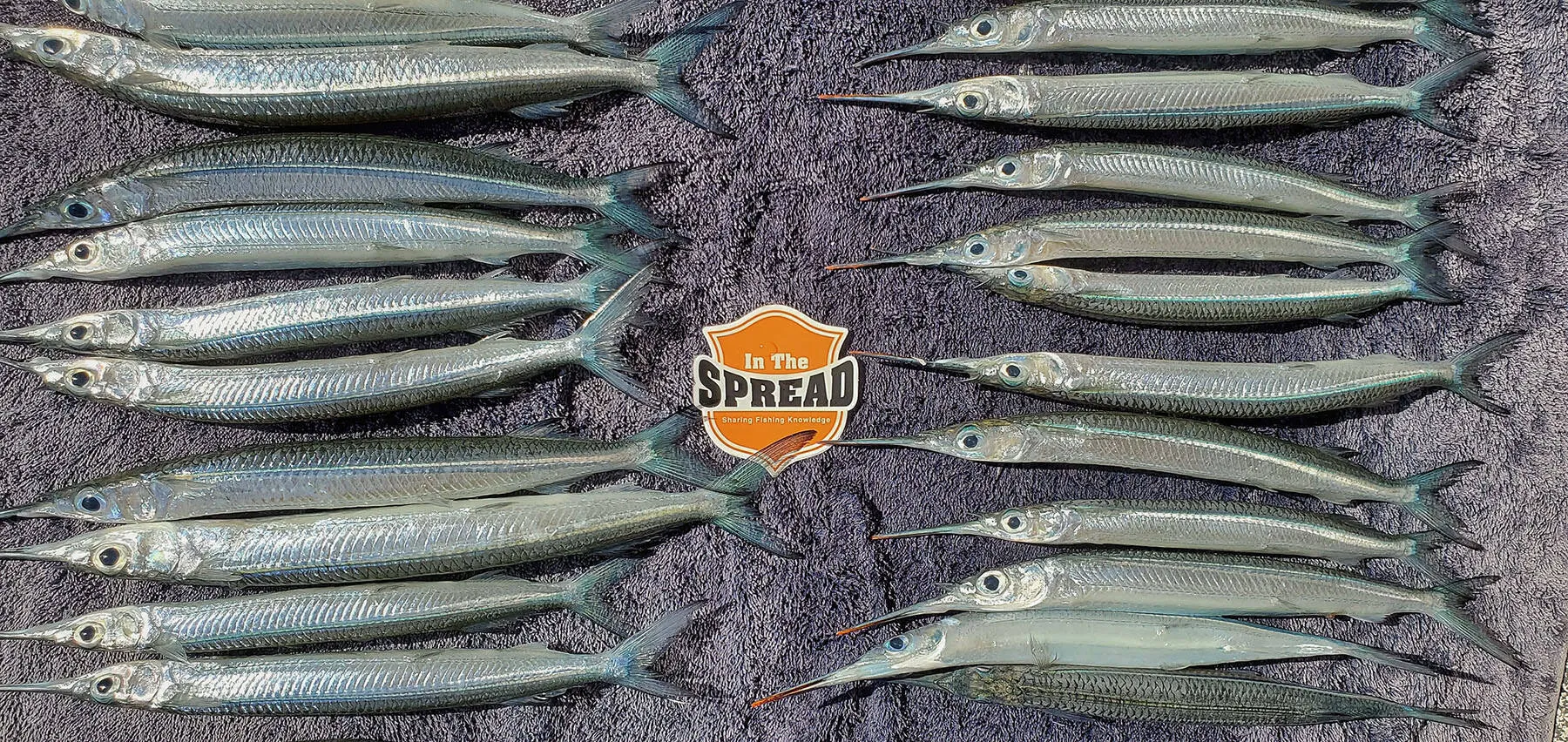
Ballyhoo fish as bait
The Ballyhoo fish has long been lauded as one of the best baits for offshore fishing, earning a coveted place in the bait boxes of many seasoned anglers. There are several reasons why Ballyhoo have garnered such a sterling reputation in the offshore fishing community:
- Lifelike appearance: Their elongated, slender bodies and vibrant silver coloration closely resemble the natural prey of many large predatory fish. When rigged properly, their lifelike appearance in the water is highly attractive to offshore game fish such as marlin, sailfish, tuna, wahoo, and dorado.
- Enticing swimming action: A well-rigged Ballyhoo bait exhibits a distinctive swimming action that mimics the movements of an injured or distressed baitfish. This side-to-side wobble and occasional burst of speed trigger the predatory instincts of game fish, making Ballyhoo difficult for them to resist.
- Versatility: The versatile nature of this fish allows them to be rigged in various ways, making them suitable for a wide range of offshore fishing techniques. From trolling to drift fishing, Ballyhoo can be effectively used to target different species in varying conditions.
- Compatibility with artificial enhancements: You can easily combine artificial enhancements, such as skirts or chuggers, to add extra color, flash, and movement to the bait. These additions increase the bait's attractiveness to predatory fish and help protect the Ballyhoo from damage during trolling.
- Scent trail: As a natural food source for many marine predators, Ballyhoo release a scent trail when used as bait that is highly attractive to game fish. This olfactory signature, signaling the promise of an easy meal, lures predatory fish closer to the angler's carefully laid trap.
- Abundance and availability: These fish are often abundant in the regions where they are used as bait, making them a readily available and sustainable bait option. This accessibility, combined with their effectiveness, makes them an attractive choice for offshore fishing enthusiasts.
- Wide range of target species: Ballyhoo's effectiveness as bait extends to a wide variety of offshore game fish species, from billfish and tuna to mahi-mahi and kingfish. Their universal appeal makes them a valuable asset in any offshore angler's arsenal.
The Ballyhoo fish's lifelike appearance, enticing swimming action, scent trail, versatility, compatibility with artificial enhancements, and wide range of target species make them a prime choice for offshore fishing. It is these factors that have solidified the Ballyhoo's position as one of the best baits for offshore angling pursuits.
Ballyhoo Bait Rigging
In the realm of angling, where a plethora of tactics and techniques abound, rigging the Ballyhoo fish as bait is an art form unto itself. Several methods have been developed to ensure the most enticing and effective presentation of the Ballyhoo to lure the ocean's most formidable predators. If you want to see step by step techniques for rigging ballyhoo several different ways, watch Rigging Ballyhoo for Offshore Fishing. Here, we shall explore several ballyhoo bait rigging methods favored by seasoned anglers. You can see exactly how each of these rigs of put together in our video:
- Pin Rig: A pin rig consists of a long-shank hook, a spring, and a baitfish rigging pin. The mouth is secured shut using the rigging pin, which is inserted through the lower jaw and then attached to the spring. The hook is then placed underneath the Ballyhoo's chin, with the point exiting near the pectoral fins. This rig allows for a natural swimming action and is popular for trolling.
- J-Hook Rig: The J-Hook rig uses a single J-shaped hook and a monofilament leader. A small hole is made in the Ballyhoo's lower jaw, and the hook is inserted through the hole, with the point exiting near the gill plate. The hook is then secured to the body using copper wire or rigging floss, ensuring the bait remains streamlined and secure during trolling.
- Circle Hook Rig: A circle hook rig is similar to the J-Hook rig but uses a circle hook instead. The hook is inserted through the mouth and exits near the gill plate, as with the J-Hook rig. The bait is then secured to the hook with copper wire or rigging floss, ensuring the Ballyhoo maintains a natural swimming action. This rig is favored for its increased hook-up ratio and reduced likelihood of gut-hooking the target fish.
- Split-Bill Rig: The split-bill rig is designed for fishing at slower trolling speeds. The Ballyhoo's mouth is opened, and the hook is inserted through the lower jaw, exiting near the gill plate. The upper and lower jaws are then secured together with copper wire or rigging floss, and the pectoral fins are splayed outward to provide additional stability and a seductive swimming action.
- Skirted Ballyhoo Rig: A skirted Ballyhoo rig features a plastic or rubber skirt placed over the fish's head, adding extra flash and color to the bait's presentation. The rigging process is similar to the pin rig or J-Hook rig, with the skirt placed over the bait before securing the hook. The skirt helps to protect the fish from being damaged during trolling and adds an extra layer of attraction for predatory fish.
Each of these Ballyhoo bait rigging methods offers its own unique advantages and can be tailored to suit the specific conditions and target species encountered during an angling expedition. By mastering the art of Ballyhoo rigging, anglers can greatly increase their chances of success in the ever-evolving dance between predator and prey.
Seth Horne In The Spread, Chief Creator
User Reviews



